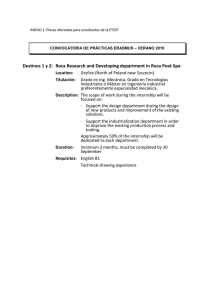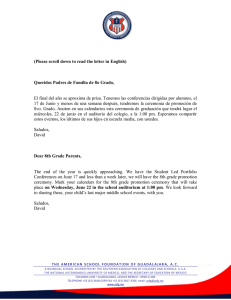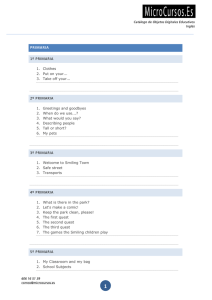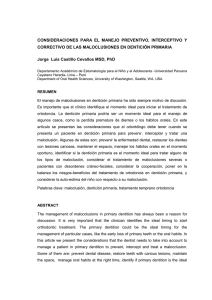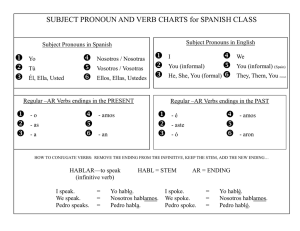Lesson 2: Fractions and proportionality
Anuncio
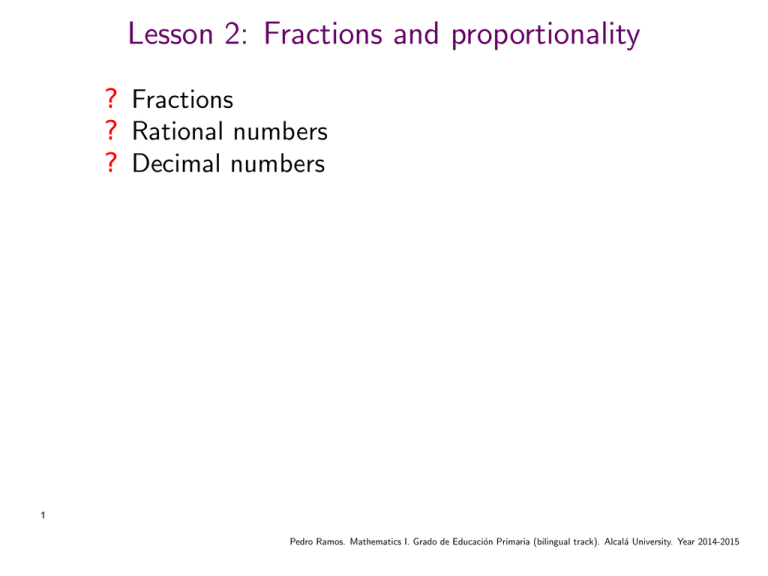
Lesson 2: Fractions and proportionality ? Fractions ? Rational numbers ? Decimal numbers 1 Pedro Ramos. Mathematics I. Grado de Educación Primaria (bilingual track). Alcalá University. Year 2014-2015 Fractions: an object, several interpretations (1) A part of the whole We have colored = of ... (2) Share (division) We want to share 3 candy bars among 5 kids. How much chocolate eats each kid? (3) A point in the number line (a number) = ¿ ? The denominator fixes the unit 2 = The numerator is the number of units you take Pedro Ramos. Mathematics I. Grado de Educación Primaria (bilingual track). Alcalá University. Year 2014-2015 Some examples ∗ What fraction of each figure is colored? (a) (b) = = = = (d) 3 (c) Pedro Ramos. Mathematics I. Grado de Educación Primaria (bilingual track). Alcalá University. Year 2014-2015 Some examples ∗ I have eaten 1/3 of the chocolates in a box and there are 12 left. How many chocolates had the box when it was full? ∗ Paul read = of the pages of a book on Monday, on Tuesday he was busy and he was able to read only = of the pages that he read on Monday, and on Wednesday he was free so he was able to read 140 pages and finish the book. How many pages does the book have? 4 Pedro Ramos. Mathematics I. Grado de Educación Primaria (bilingual track). Alcalá University. Year 2014-2015 Definition of fraction. Option 1 ∗ A fraction is the quotient of two integer numbers, i.e., an expression of the form a=b, with b 6 . ∗ Interpretations: ? part of a whole. ? solution to a share-out problem. ∗ Fractions such = , = , = ; : : : represent the same quantity, i.e., they are the same rational number. ∗ Def: We say that a number is rational if it can be expressed as the quotient of two integers, i.e., if it can be expressed as a fraction. The set of rational numbers is denoted by Q. 5 Pedro Ramos. Mathematics I. Grado de Educación Primaria (bilingual track). Alcalá University. Year 2014-2015 Definition of fraction. Option 2 ∗ Using the number line. Given two integers a and b (with b 6 ), the fraction a=b represents the following point of the number line: ? take segment ; and divide it into b equal parts. ? take a of those equal parts. ∗ The main advantadge of this option is that it makes clear, from the beginning, that fractions are an extension of the set of numbers already known. ∗ Doing exercises as Represent = and = in the number line helps in developping some intuition about fractions and its meaning. 6 Pedro Ramos. Mathematics I. Grado de Educación Primaria (bilingual track). Alcalá University. Year 2014-2015 Definition of fraction. Option 2 ∗ If we have introduced this interpretation of fractions, we can ask directly the question: How much is ? ∗ For a kid working on this question on the number line (and with graph paper) it is much easier to understand the impossibility of adding up fractions that do not have the same denominator. 7 Pedro Ramos. Mathematics I. Grado de Educación Primaria (bilingual track). Alcalá University. Year 2014-2015 Equivalent fractions. Addition and substraction ∗ The concept of equivalent fractions is one of the most important ones in this subject. Given the fraction a=b, fractions that are obtained multiplying (or dividing) numerator and denominator by the same (non-zero) integer are called equivalent to fraction a=b. ∗ It is very important to understand that equivalent fractions represent the same part of a whole, and the same point on the number line. = 8 Pedro Ramos. Mathematics I. Grado de Educación Primaria (bilingual track). Alcalá University. Year 2014-2015 Equivalent fractions. Addition and substraction ∗ Once the concepts of fraction and equivalent fractions are properly understood, addition and substraction should be easy to understand. a) Fraction with different denominators cannot be added (nor substracted). b) Therefore, before adding or substracting we have to find equivalent fractions with the same denominator. ∗ Example: 9 Pedro Ramos. Mathematics I. Grado de Educación Primaria (bilingual track). Alcalá University. Year 2014-2015 Improper fractions, mixed numbers, integer division ∗ A fraction such as = (in general, fractions a=b where a ≥ b) are usually called improper fractions and can also be represented as mixed numbers: ∗ In general, if a q · b r, fraction a=b can be represented r a r also as q . From my view, it is better q . b b b ∗ It is important to keep in mind that if option 1 has been used (part of a whole), improper fractions are a nontrivial generalization: what does eight sevenths of something mean? 10 Pedro Ramos. Mathematics I. Grado de Educación Primaria (bilingual track). Alcalá University. Year 2014-2015 Multiplication of fractions ∗ If we think only in the algorithm, multiplying fractions is much easier than adding them. Nevetheless, the concept is much more complicated. ∗ A good possibility is to generalize from integers, as follows: ? · is “the double of 18” ? · is “one third of 18”, i.e., ∗ It is worth to pay attention here to a very important relation between multiplication and divisionr: multiplying by 11 n is the same as dividing by n Pedro Ramos. Mathematics I. Grado de Educación Primaria (bilingual track). Alcalá University. Year 2014-2015 Multiplication of fractions ∗ Once that we understand the mutiplication of =n by an integer (as a division by n) we can multiply =n by other fraction: a) · b) · ∗ Now, it is easy to understand that · · · · · · · X means · of X: · · · · 12 Pedro Ramos. Mathematics I. Grado de Educación Primaria (bilingual track). Alcalá University. Year 2014-2015 Multiplication of fractions. Option 2 = × = Here it can also be seen that × 13 means of . = = Pedro Ramos. Mathematics I. Grado de Educación Primaria (bilingual track). Alcalá University. Year 2014-2015 Division ∗ First, something what I think it is not a good alternative. 14 Pedro Ramos. Mathematics I. Grado de Educación Primaria (bilingual track). Alcalá University. Year 2014-2015 Division ∗ Option 1: Reduce to common denominator. Quotative division of “quarters” in “quarters” is easier to understand. ∗ The number line can be useful: → how many times does “fit” in ? 15 Pedro Ramos. Mathematics I. Grado de Educación Primaria (bilingual track). Alcalá University. Year 2014-2015 Division ∗ Option 2: Division as inverse of multiplication. Divide is the same as multiplying by the inverse. ∗ We had already found this idea: multiply by =n is the same as divide by n. ∗ The inverse of a rational number a is a number b such that a·b . ∗ Every rational number not equal to zero has an inverse. a) The inverse of an integer n is =n. b) The inverse of a rational number p=q is q=p 16 Pedro Ramos. Mathematics I. Grado de Educación Primaria (bilingual track). Alcalá University. Year 2014-2015 Division ∗ Therefore, · ∗ Of course, once the operation has been defined, the best way of fully understanding it is to solve problems such as: We have a barrel with 350 liters of water, and we want to fill up bottles with capacity = of liter. How many bottles will we fill up? ∗ If operations with fractions have been understood, we should be able to solve (without algebra) problems like this one: A person leaves = of his heritage to his only daugther, = of the remaining part to an old uncle, he has to pay as taxes = of the total heritage and he donates the rest, euros, to charity. What was the total value of his heritage? 17 Pedro Ramos. Mathematics I. Grado de Educación Primaria (bilingual track). Alcalá University. Year 2014-2015 Exercise ∗ Compute and express as an irreducible fraction × × − × − − 18 Pedro Ramos. Mathematics I. Grado de Educación Primaria (bilingual track). Alcalá University. Year 2014-2015 Order in Q ∗ Order in Q is defined in the same way as in natural numbers: given two rational numbers a and b, we say that a < b if b − a > . ∗ Properties of inequalities: a) If a < b then a c<b c (for every rational number c). b) If a < b and c > , then a · c < b · c. c) If a < b, then −a > −b. Therefore, if a < b and c < , then a · c > b · c ∗ Exercise: Find all rational numbers x for which −x< 19 Pedro Ramos. Mathematics I. Grado de Educación Primaria (bilingual track). Alcalá University. Year 2014-2015 Order in Q ∗ Rational numbers are “dense”: in Q the “next number” does not exist. Remark: between any two rational numbers there exist an infinite number of rational numbers. ∗ But there are √ numbers that are not rational: Theorem: is not a rational number. ∗ Last remark: The set of rational numbers is “countable” (we can make a list with all of them). (Of course, the list is infinite). 20 Pedro Ramos. Mathematics I. Grado de Educación Primaria (bilingual track). Alcalá University. Year 2014-2015 Problem ∗ We have a bathtub with two faucets. It takes 1 hour for the hot water faucet to fill in the bathtub, while it takes 30 minutes for the cold water faucet. If both faucets are opened at the same time, and the flow in each of them is the same as when they were opened alone, how long will it take for the bathtub to be full of water? 21 Pedro Ramos. Mathematics I. Grado de Educación Primaria (bilingual track). Alcalá University. Year 2014-2015 Decimal numbers ∗ Decimal numbers with finite expression: decimal fractions. A decimal fraction is a fraction that is equivalent to another one whose denominator is a power of . ∗ Example: = is a decimal fraction because it is equivalent to = . ∗ What can be said about the denominator of a decimal fraction? ∗ In 1585 Belgian mathematician Simon Stevin proposed to represent quantities smaller than the unit considering divisions in tenths, hundredths, .... For instance: 22 Pedro Ramos. Mathematics I. Grado de Educación Primaria (bilingual track). Alcalá University. Year 2014-2015 Decimal numbers ∗ Decimal part can be seen as generalizing to negative powers of 10 what we have make for the integer part. : where · : · · · − · − · − ∗ Review of basic arithmetic with decimal numbers. ∗ Mental calculation is also useful here. For instance: a) 0 0 b) 0 c) · 0 23 Pedro Ramos. Mathematics I. Grado de Educación Primaria (bilingual track). Alcalá University. Year 2014-2015 Decimals in the number line : ? : ? : 0 : ? 0 ? 24 Pedro Ramos. Mathematics I. Grado de Educación Primaria (bilingual track). Alcalá University. Year 2014-2015 Decimal ↔ fraction ∗ For decimal fractions (decimal numbers with finite expression) conversion is easy. Examples: a) b) : 25 Pedro Ramos. Mathematics I. Grado de Educación Primaria (bilingual track). Alcalá University. Year 2014-2015 Decimal ↔ fraction. Infinite expressions ∗ A lot of rational numbers do not have a finite decimal expression. Examples: = , = , = , ... ∗ A number like 0 · · · is called repeating decimal number, and it is denoted by : . ∗ In a repeating decimal number there are two possibilities: 1. The full decimal part is repeated, as in : : · · · pure repeating decimal 2. Only a part of the decimal part is repeated, as in 0 · · · mixed repeating decimal : 26 Pedro Ramos. Mathematics I. Grado de Educación Primaria (bilingual track). Alcalá University. Year 2014-2015 Decimal expression of rational numbers ∗ Theorem: The decimal expression of every rational number is either finite or repeating (pure or mixed). ∗ Examples: : : : ∗ How to express a repeating decimal as a fraction: “fracción generatriz”. ∗ Example: express as an irreducible fraction a) : b) : 27 Pedro Ramos. Mathematics I. Grado de Educación Primaria (bilingual track). Alcalá University. Year 2014-2015 Final remarks ∗ Decimal expression is not unique. a) : b) c) : ··· : 0 : 0 ∗ Theorem: The set of decimal numbers is not countable. This means that it is not possible to put in a list the set of decimal numbers (even the set of decimal numbers in the interval ; ). 28 Pedro Ramos. Mathematics I. Grado de Educación Primaria (bilingual track). Alcalá University. Year 2014-2015

